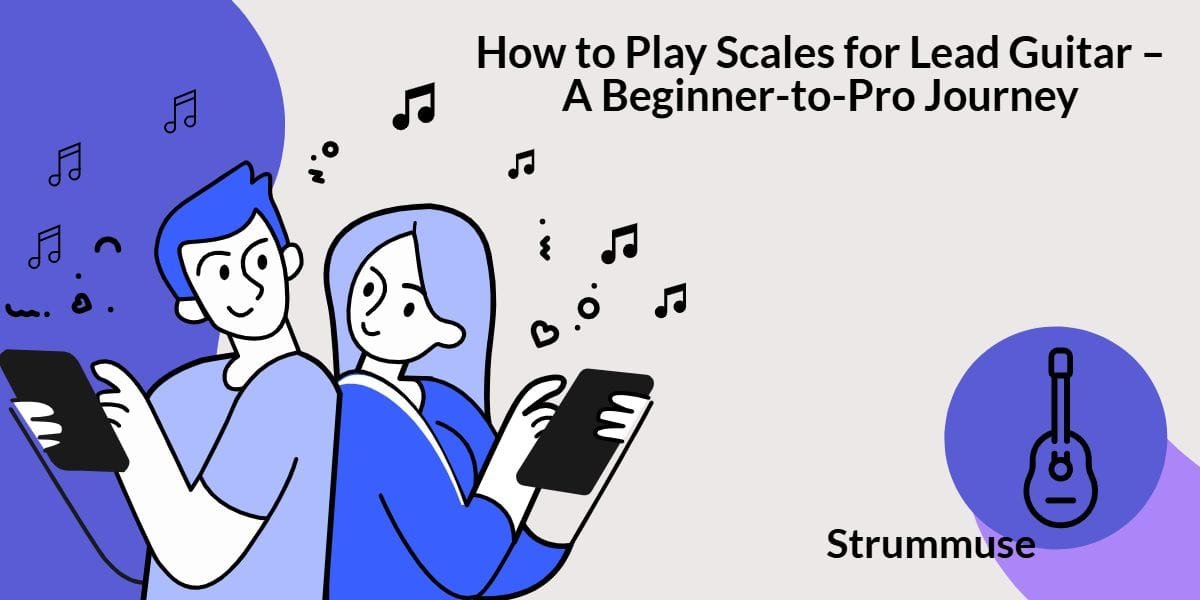1. Why Scales Are Crucial for Lead Guitar
If chords are the foundation of a song, then scales are its soul. Whether you’re crafting solos, improvising on stage, or jamming with friends, your lead guitar journey starts with mastering scales.
When you learn scales:
- You stop “guessing” notes
- Your fingers move with purpose
- You sound musical—not mechanical
Lead legends like Slash, Satriani, or Indian icons like Ehsaan Noorani? They didn’t start with licks, they started with scales.
2. Understanding the Language of Music
Before we shred, let’s simplify some theory.
What is a Scale?
A scale is just a sequence of notes in a particular order, usually within an octave. Think of it like a color palette from which melodies are painted.
Most Used in Lead Guitar:
| Scale Name | Mood | Example Use |
|---|---|---|
| Major Scale | Happy / Bright | Pop, Bollywood intros |
| Minor Scale | Emotional / Melancholy | Romantic leads |
| Pentatonic | Raw / Groovy | Rock, Blues, Folk |
| Blues Scale | Gritty / Soulful | Classic solos |
3. Top 3 Scales Every Lead Guitarist Must Learn
Let’s go hands-on now. Here are the essential scale patterns you should memorize first.
A Minor Pentatonic (Box 1)
The #1 lead scale. Used in 90% of beginner guitar solos.
e|-----------------5--8--
B|-------------5--8-----
G|---------5--7----------
D|-----5--7--------------
A|-5--7------------------
E|-5--8------------------
✅ Use this over Am, C, G chord progressions.
🎧 Try it over:
- “Tera Ban Jaunga” (Capo on 1st fret – See chords)
- “Tum Mile” unplugged version
C Major Scale (CAGED Friendly Shape)
e|------------------7-8--
B|--------------8-10-----
G|--------7-9-10----------
D|--7-10------------------
A|--8-10------------------
E|--7-8-------------------
This pattern gives you bright, melodic soloing options. Learn it in all positions.
🎧 Try it over:
- “O Sajni Re”
- “Tum Hi Ho” intro solo
E Blues Scale
e|-----------------12-15--
B|-------------12-15-----
G|--------12-14-15--------
D|-----12-14--------------
A|-12-13-14---------------
E|-12-15------------------
Add bluesy tension—great for solos with attitude.
4. CAGED System – Unlock the Fretboard
The CAGED system teaches you to move scales across the neck using 5 chord shapes:
C – A – G – E – D
Each shape = scale pattern.
Example:
- E minor scale using E shape → move to 5th fret → you’re in A minor
- Link patterns to go from soloing in one box to full neck freedom
Want a visual breakdown? Check Here
5. 30-Min Daily Practice Routine
| Time | Task |
|---|---|
| 5 min | Warm up: Basic alternate picking |
| 10 min | Play 2 scale boxes (slow to fast) |
| 5 min | Connect root notes across patterns |
| 5 min | Practice bends, hammer-ons in scale |
| 5 min | Jam to a backing track in A minor |
🎯 Pro tip: Record yourself weekly — you’ll hear the progress you can’t see.
Helpful Links :–
6. How to Improvise Using Scales
Learning scales isn’t enough—you’ve got to make music with them.
🎯 Start Simple
- Use only 3 notes from a scale
- End phrases on root or chord tone
- Repeat licks — don’t overplay
🎯 Add Flavor
- Bends & slides make solos expressive
- Leave space between notes
- Use dynamics (soft, loud, pause, etc.)
🎧 Example Practice Backing Tracks:
- “Sad Bollywood Beat in Am” – [Use A minor pentatonic]
- “Happy Progression in G” – [Use G major scale]
7. Common Mistakes to Avoid
| Mistake | Fix |
|---|---|
| Playing too fast | Focus on tone & phrasing |
| Ignoring the root | Always “land” your lick back to root note |
| Staying in 1 box | Learn transitions & connect patterns |
| Only going up/down | Practice in 3s, 4s, 5s… get creative |
Check:- Biggest Mistake I Made as a Beginner, so you don’t have to
8. What’s Next? Explore Modes, Fusion, Ragas
Once you’re confident with basics, here’s what’s next:
- Learn all 5 pentatonic boxes
- Understand major/minor modes (Dorian, Mixolydian)
- Try Raga-based leads for Indian classical fusion
- Learn licks from your favorite guitar solos and rebuild them using scales
🎧 Check out our guide:
👉 10 Indian Classical Scales to Practice on Guitar
9. Helpful Strummuse Resources
Explore these curated tutorials from our library:
And if you’re starting out:
👉 The Ultimate Beginner’s Guide to Guitar Playing
Conclusion
Learning lead guitar scales is a game-changer for your playing. It opens up:
- Solos that sound like real music
- Confidence to improvise
- Freedom to jam with any band, anywhere
And remember:
“You don’t need speed. You need soul. Scales teach you both.”
Stick to the 30-minute daily plan, explore new sounds, and let your fingers tell your story.
Have questions or need scale diagrams for a specific key?
Drop a comment or DM us on Instagram @strummuse — we respond fast and with love ❤️

